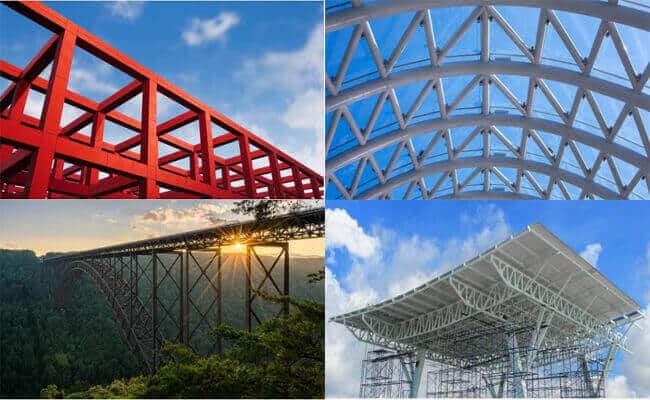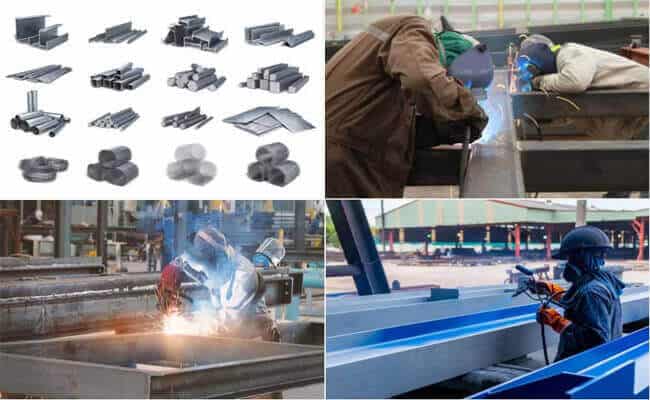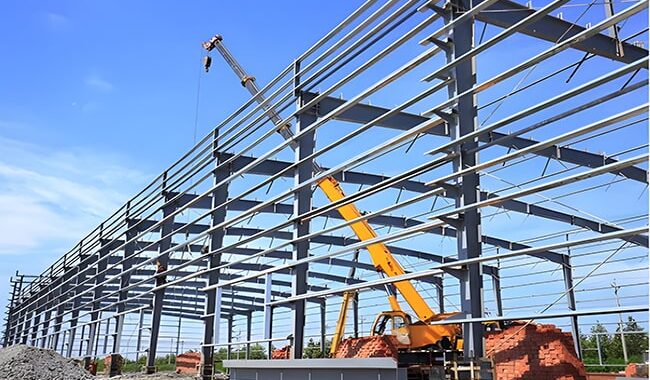In the construction of modern storage facilities, steel structure warehouses have become one of the mainstream building forms due to…
Steel structure fabrication is the process of constructing steel structures by cutting, bending, and assembling raw steel materials. The finished structures can be used for various purposes, such as building bridges, towers, and large commercial buildings. The process of steel structure fabrication involves several steps, including design, cutting, welding, assembly, and painting.

The type of Steel structure:
1. Equipment steel structure
The steel structure of equipment mainly refers to the steel structure part of various large-scale equipment that uses steel structures. This type of steel structure generally plays a load-bearing and stable role in the equipment, such as the tower steel structure of the bridge erecting machine, large equipment brackets, etc.
2. Marine steel structure
Offshore steel structures mainly refer to platforms built with steel structures at sea. Because they are often subjected to wind and wave attacks, seawater corrosion, and harsh working environment conditions, the requirements for this type of steel structure are very high, mainly including offshore oil—drilling platforms, jacket platforms, jack-up platforms, semi-submersible platforms, etc.
3. Building steel structure
Building steel structure mainly refers to the steel structure part used in various buildings instead of the concrete form. It is widely used in industrial and civil buildings because of its high strength, good earthquake resistance, short construction period, green environmental protection, and other advantages. The common ones are super-high buildings, industrial plants, steel structure houses, villas, etc.
4. Bridge steel structure
Because the steel structure has a solid load-bearing capacity and good durability, the load-bearing system of modern bridges is mainly made of structural steel. With the development of technology, bridge steel structures have become increasingly mature in terms of load, manufacturing process, material properties, installation methods, and maintenance methods. The common ones are all kinds of steel structure bridges.
5. Space grid steel structure
Space grid steel structure building refers to a steel structure building with a large space span, mainly divided into grid structure, suspension cable structure, shell structure, pipe truss structure, membrane structure, and other types and widely used in factories, stadiums, railway stations, large conference rooms, etc.
6. Hydraulic steel structure
Water conservancy steel structure mainly refers to the steel structure used in water conservation projects. There are still quite a few, such as steel structure platforms, gates, trestles, etc.
Steel structure buildings have their professionalism and complexity, and some difficult problems will inevitably arise during construction. However, our production team will record and seek the best solution in time and continue to optimize so that some problems no longer appear.
The process of steel structure fabrication
Design: The first step in steel structure fabrication is to design the structure. This involves creating detailed plans and blueprints for the structure, taking into account the loads it will need to bear, the local weather conditions, and any other relevant factors. The design is then reviewed and approved by a structural engineer to ensure that it is safe and meets all relevant building codes and regulations.
Cutting: After the design is approved, the raw steel is cut to the required lengths and shapes. This is typically done with a plasma or water jet cutter, which is a high-precision machine that can accurately cut steel to the required dimensions.
Welding: The next step is welding, which involves joining the steel parts together to form the structure. This is done by a skilled welder who uses an electric arc or gas-powered welding torch to heat the metal and create a strong bond between the parts. The welder must have a good understanding of the properties of steel and be able to use welding techniques that will produce a strong, durable bond.
Assembly: Once the steel parts are cut and welded, they are ready to be assembled into the final structure. This is done by a team of skilled workers who use cranes, hoists, and other equipment to position the parts and bolt them together. The assembly process must be carefully planned and coordinated to ensure that the structure is stable and free from any defects.
Painting: The final step in steel structure fabrication is painting. This involves applying a protective coating to the steel to prevent it from rusting and to improve its appearance. The painting process must be done carefully to ensure that the coating is uniform and does not contain any defects.
Steel structure fabrication is a complex and demanding process that requires skilled workers, high-precision equipment, and careful planning. Despite the challenges, steel structure fabrication has many advantages, including its strength, durability, and resistance to fire, earthquakes, and other natural disasters. This makes it a popular choice for building large structures such as bridges, towers, and commercial buildings.

How to avoid problems in steel structure fabrication
Raw materials
Raw materials are unloaded at will during transportation and storage, and they are piled up in a disorderly manner, resulting in the deformation of components, bruises, and environmental pollution; when the raw materials of steel structure buildings are processed, the cut plate specifications are different, it will lead to steel beams, and parts are inconsistent, the cutting edges have relatively deep cuts, the metal sheet edges have significant dents or rather deep zigzag marks, and the cutting is not smooth enough.
Lofting and blanking process
The process belongs to the top part before the parts are processed, and its quality directly affects the following procedure and even causes all the cut parts to be scrapped. This situation is prevalent, so it is essential to strengthen the process’s quality control before cutting. Therefore, we must pay great attention to such issues in construction and inspection.
Steel structure fabrication for painting
The process is also hidden, and the impact on the structure is less than the impact on the building function. It is also a process prone to quality problems. The main quality problems are: the paint film on the surface of the component is partially peeled off in a large area; the paint film on the surface of the component is peeled off; the thickness of the paint film is not enough; the thickness of the paint film is unevenly distributed; the color difference of the paint film is large. The rust removal of steel structural components was sloppy before welding, and the specified level was not achieved. The residues were not cleaned before painting, and there were many wastes, unevenness, and sagging. Failure to remove rust in time will cause the paint to rust and fall off, and the paint layer will be uneven in thickness.
Steel structure fabrication for welding
Steel structure welding is prone to quality problems. In 2004, a company’s product quality report showed that among the quality problems in this process, the reflow rate caused by welding quality was over 80%, followed by the operation errors of the previous cycle and the welding quality problems caused by technical issues of operators. About 10% of the type of problem is the main problem that directly affects the quality of the project. Therefore, this problem requires a professional inspection company to use professional inspection tools for inspection and evaluation. According to the type of defects in the weld, it is divided into slag, undissolved, porosity, etc.
There will be various problems in the processing of steel structures, and our factory has constantly been exploring so that multiple issues do not recur. Based on experience, try to avoid various problems and find the best solution times when encountering problems. In addition to the difficulties encountered in the processing process, different issues will occur in the packaging and transportation of steel structural parts before arriving at the site and in the later installation process. Tested on countless projects, our quality is proven. We have been committed to giving customers the most satisfactory results!














